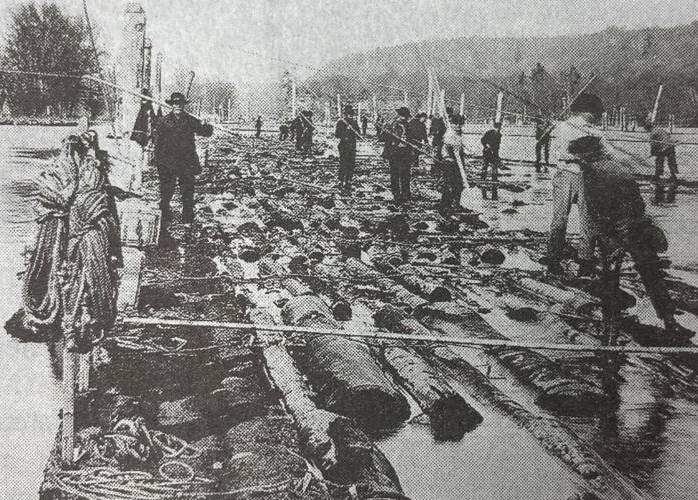At its peak, the boom extended over nine miles of river upstream, a reflection of the enormous scale of lumber production that placed Minnesota behind only Wisconsin and Michigan between 1880 and 1910. However, by the time it closed, most sorting pens, hillside structures, and other facilities had been dismantled or left to decay. The final logs that passed through in 1914, the last of an estimated fifteen billion board feet since the company's inception, were part of the previous season's drive.
First organized in 1851 with a capital stock of $10,000, the St. Croix Boom Company constructed its initial boom near an island across from Osceola, Wisconsin. Logs floated downriver from logging camps were gathered, sorted, measured, and grouped for distribution. As production increased, the original channel proved too narrow. Under new ownership, the company secured a revised charter in 1856, expanded its capital stock to $100,000, and constructed a new boom a few miles north of Stillwater, where the Apple River's added flow proved ideal.
The process remained largely the same. Each logging camp marked its logs with a unique symbol, registered with the surveyor general to establish ownership. These marks, typically stamped into the bark or carved into the wood, identified which camp had felled each log. Once marked, the logs were released into the river or its tributaries to float downstream toward the boom.
At the boom, a series of barriers called a 'catch boom' stopped the drive for sorting. Workers known as catch markers examined and verified each log's original camp mark—of which there were over 2,000 registered from as many as 50 to 60 camps operating simultaneously—and re-marked them. After verification, logs were guided through a 'sorting gap' and directed into holding pens, where they were assigned a unique identifier number, measured for volume, and organized for transport by 'fitting-up crews' to the owner's respective sawmills.
The boom's success, however, was not without significant operational challenges. In 1886, a major log jam upriver near Taylor's Falls disrupted operations at the boom. The logs had become lodged at Angle Rock, a ninety-degree bend in the river. An estimated 125 to 150 million board feet were trapped, forming a jam more than two miles long. Efforts to relieve it—including steamboats, land-based steam engines, and horse teams—illustrated the scale and technological resourcefulness of late nineteenth-century river operations. On July 2, several thousand pounds of dynamite split the jam, freeing millions of board feet. Cleanup continued into September. In 1890, the Nevers Dam was constructed to help regulate the flow of both logs and water, built by the Weyerhaeuser Syndicate which had taken controlling interest.
Logging on the St. Croix began as early as the 1837–1838 season, producing about 300,000 board feet—a figure that grew to 110 million by 1852–1853. The peak of 492 million came in 1890, but years of overexploitation soon impacted the industry. After cutting 271 million board feet in 1904, the area's output fell to 121 million the following year, and by 1907 most of Minnesota's commercially valuable pine had been harvested. Rapid decreases continued, accelerated by the Panic of 1893 which bankrupted many operators and shifted transport to railroads. The boom company could no longer sustain operations.
At its height, the St. Croix Boom had been highly lucrative, aided by the state's generous charter fees and an adaptable design that allowed sections to open and close with the in-flow of logs. However, industrialization and shifting attitudes towards the river ultimately led to its downfall. The once-lush valley had been heavily deforested, trains had replaced river transport, and as steamboats became more vital to nearby towns, the logs that had once impeded navigation were cleared from the waterway. Soon after the final log was hitched through the boom, the Army Corps of Engineers dismantled much of the site as a navigation obstruction, though some structures and pilings remained.
More than half a century later, in 1966, the site was listed on the National Register of Historic Places for its contributions to the region as the earliest, most important, and longest-lived of the major log storage and handling areas in Minnesota.
 Minnesota Then
Minnesota Then


